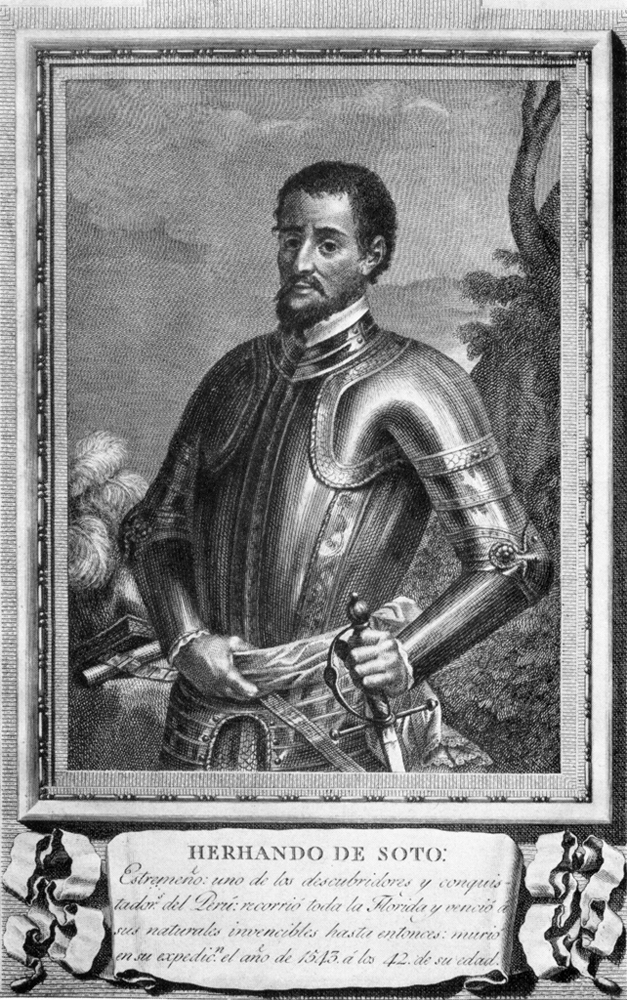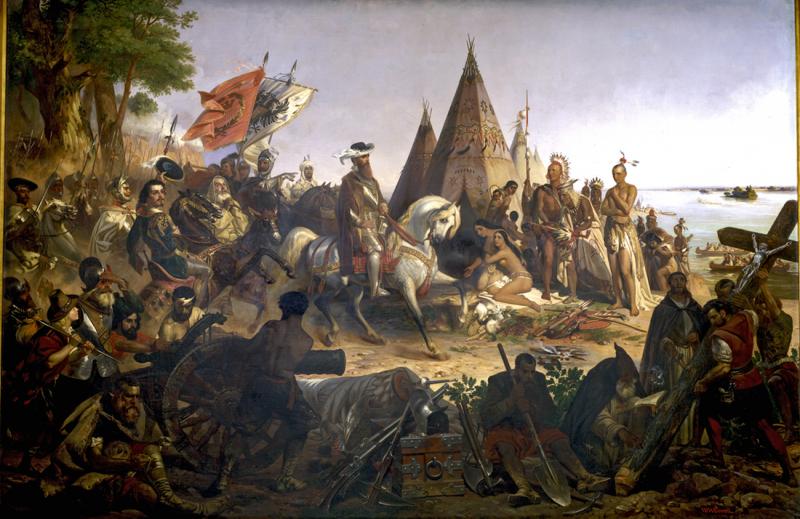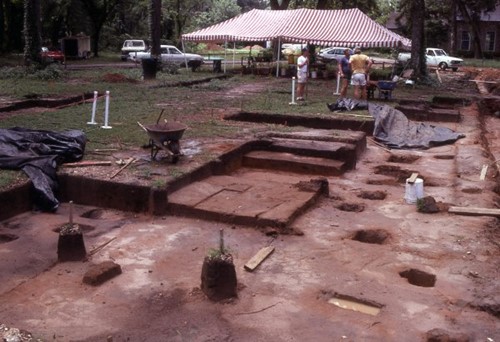Hernando De Soto’s expedition through the southeastern United States in 1539–43 was one of the earliest of the early contacts between Europeans and native peoples. While historical documents tell the story of do Soto's journey, advances in both history and archaeology have enabled researchers to reconstruct the de Soto route.
In March 1540 the Spanish explorer Hernando de Soto reached the territory of the Ichisi, in what is now central Georgia. Surprised by the approaching strangers, the Ichisi chief sent an emissary to de Soto's party with three blunt questions: Who are you? What do you want? Where are you going?
The Indians' bewilderment is easily understood: These were the first Europeans they had ever seen.
The 500th anniversary of the voyages of Christopher Columbus has prompted an unprecedented examination of just such encounters. Researchers have long been interested in the native cultures of the Americas and how they were changed by the first Europeans and Africans to reach their shores. But the added public attention and financial support inspired by the Columbus quincentenary, to say nothing of important advances in history and archaeology, have encouraged a burst of new research in the last decade or so into the whole of what scholars call the "early contact" period.
"It's a wonderful period, where we're undergoing a quantum leap in our knowledge," says Jerald T. Milanich, curator in archaeology at the Florida Museum of Natural History.
De Soto's expedition through the southeastern United States in 1539–43 was one of the earliest of the early contacts between Europeans and native peoples. Research on the expedition has contributed in no small way to the "quantum leap" in our understanding of the age.
In a cluster of related projects that have drawn on an unusual cross-fertilization between historical and archaeological research, a group of scholars in the Southeast is attempting to plot the route that de Soto took, as a way of understanding the "social geography" of the native societies he met. The work on the de Soto expedition offers a revealing snapshot of the growing body of research on the earliest encounters between the civilizations of Europe and the Americas.
De Soto's march, through territory then known as "La Florida," was the first major European expedition into the interior of the Southeast -- and one of the earliest anywhere into the country's interior. De Soto's men were the first, and possibly the last, Europeans to see the great Indian chiefdoms of what archaeologists call the "Mississippian period."
Four major historical documents -- three of them written by men on the expedition -- and a fragment of a fifth tell the story of de Soto's journey.
Hoping to find the riches that other Spanish explorers had discovered in Central and South America, de Soto landed in May 1539 near Tampa Bay, Fla., with about 600 men, a few hundred horses, packs of dogs, and a large herd of pigs. The army set out north and west through Florida. Along the way, as it did along its entire route, the expedition encountered a variety of native societies. Sometimes the encounters were peaceful, sometimes violent. Periodically, the expedition would stop for a few days' or weeks' rest; each winter they set up camp for several months. Typically, as they moved on, de Soto's army enslaved men and women from American Indian tribes along as servants or aides.
From Florida, the expedition moved north through what is now Georgia and the Carolinas, west into Tennessee, back down through northwestern Georgia, and into Alabama where, at a town called Mabila, de Soto's army and local Indians engaged in a fierce battle in which some 2,500 natives perished. From there, de Soto's party headed northwest into Mississippi and Arkansas.
In the spring of 1542, de Soto died of a fever. His army then set out to find a land route through Texas to Mexico, but dwindling supplies forced them to turn back. In June 1543 they set out down the Mississippi River in seven boats, which sailed into the Gulf of Mexico six weeks later with 311 surviving Spaniards and an unknown number of enslaved people from various American Indian tribes. No gold or other riches had been found.
A defining characteristic of the research on the de Soto expedition has been an unusual degree of cooperation between historians and archaeologists, who have been making use of advances in each other's discipline both to foster and to confirm research in their own.
Major work on identifying the actual route de Soto took has been done over the last decade by Charles Hudson, a professor of anthropology and history at the University of Georgia, and his graduate students. The project was inspired, he says, by the idea of linking archaeological knowledge with the historical record.
"In the late 70's, some of us realized that history and prehistory had never been connected in the Southeast," says Mr. Hudson. "This meant that prehistorians were working away in isolation from historians and social anthropologists, and whole bodies of information existed in isolation from each other."
De Soto was a natural to penetrate that isolation, he says: "The de Soto expedition was the first occasion that native peoples of the Southeast entered the historical record."
Advances in both history and archaeology enabled Mr. Hudson and his students to reconstruct the de Soto route. The chronicles of de Soto's own expedition lack the precise geographical information that would allow researchers to pin down the location of the places he visited. But by cross-referencing those narratives with other, lesser-known documents of later expeditions to some of the same places, Mr. Hudson and his colleagues were able to corroborate certain legs of the journey. That, in turn, allowed them to speculate with greater certainty about other parts.
At the same time, Mr. Hudson was able to take advantage of information that archaeologists had amassed about where different native societies were located in the years before the Europeans arrived.
"De Soto not only encountered people, he encountered wildernesses, and some of them were vast," Mr. Hudson says. "Some of the most important pieces of evidence are where people were not living."
Despite some impressive detective work, Mr. Hudson acknowledges that there is not a single spot along the route that can be ascertained with absolute certainty.
A number of archaeologists, however, profiting partly from Mr. Hudson's work, have identified sites that come close. The place about which they are most certain is the main town of the Apalachee territory, near present-day Tallahassee, Fla., where de Soto and his army spent the winter months of 1539–40.
"It is the only solid, no-kidding-the-Spanish-stood-on-this-spot site on the de Soto route," says Charles R. Ewen, a research administrator at the Arkansas Archaeological Survey, who helped direct the excavation of the site, known as the Martin site, in 1987.
The Spanish may have been at Apalachee, but did de Soto himself stand on that spot? Mr. Ewen is pretty sure he did, and the evidence that he and his colleagues put together is indicative of the kind of interdisciplinary detective work that has marked the research on de Soto.
In addition to the Indian artifacts and remains of Indian architecture at the site, he says, an abundance of early-16th-century artifacts helps to place Spanish explorers at Apalachee at the right time. Archaeologists have found Spanish pottery and jars, links of chain mail, copper coins, colored chevron beads, and one tubular blue glass bead known as a "Nueva Cadiz" after a town in Venezuela where identical ones have been found. Even though only one such bead was found at the site, Mr. Ewen says it is an important "marker" -- an artifact whose date and place of origin are so firmly established that it can "bracket a site pretty tightly."
It is possible, Mr. Ewen says, that the Spanish artifacts are at the site as a result of an earlier, unsuccessful expedition into the region by Panfilo de Narvaez. But researchers also found the archaeological equivalent of a smoking gun: the upper jaw of a pig, an animal not native to the area. Archaeologists know, from the historical documents, that de Soto had a herd of pigs with him. Narvaez, whose company was starving by that time, very likely did not.
Another site with evidence nearly as convincing -- no pig jaws -- is known as Tatham Mound, in west central Florida. According to Jeffrey M. Mitchem, who directed the excavation of the mound in 1985 and 1986, archaeologists uncovered the buried remains of several hundred native people, plus hundreds of glass and metal beads, silver and gold, a piece of armor plate, and other Spanish artifacts.
"The beads were absolutely, positively early 16th century," says Mr. Mitchem, an archaeologist at the Arkansas Archaeological Survey and an assistant professor of anthropology at the University of Arkansas.
A key to the identification of the mound as a de Soto site, however, was the discovery of two bones with evidence of wounds inflicted by an edged metal weapon, such as a sword or a halberd.
Artifacts, Mr. Mitchem notes, always carry a degree of uncertainty, because they are transportable; beads, especially, could easily have been traded from one native group to another.
"But cut bones argue for face-to-face contact," he says. "There was definite physical contact with the Spaniards." And, while once again Narvaez is a suspect, he is known from the historical record to have stuck close to the Florida coastline. Tatham Mound is fairly far inland, where de Soto is thought to have gone.
"Bioarchaeological" evidence like the cut bones has proved to be a key piece of the de Soto puzzle. Robert L. Blakely, an associate professor of anthropology at Georgia State University, recently completed a six-year project analyzing bone fragments from what is known as the King site, which in the early 16th century was an Indian village in the chiefdom of Coosa, in northwest Georgia.
Many of the bones show evidence of wounds from edged metal weapons, Mr. Blakely says. While the weapons were definitely not indigenous, he says, they could have been used by Indians who got them from the Spanish. But the placement of the wounds, mostly on the victims' heads and legs, points to the Spanish: Trained in European combat methods, Mr. Blakely says, Spanish warriors would most likely have attacked those areas on the body that, on a European opponent, were least heavily armored.
The combination of evidence, Mr. Blakely says, has yielded "90-per-cent agreement" that the King site was a stop on de Soto's route.
Other spots along de Soto's route remain a mystery. Archaeologists would love to find the site of the battle at Mabila, in Alabama. And although the expedition spent two years in Arkansas, no sites there have been firmly established, possibly because by then the Spanish were running out of things to leave behind. A bit of tantalizing evidence in the form of a glass bead and a brass bell suggests that the Parkin site in eastern Arkansas may have been a place de Soto visited called Casqui, but that's all the researchers have found so far.
Despite what might look like a fixation on de Soto's itinerary, the larger purpose of the research on his expedition is to acquire a firmer understanding of the native societies of the early 16th century and how they were affected by what is called the Spanish entrada.
"Once we began doing this," says Mr. Hudson of the University of Georgia, "what began to emerge was a social geography of the 16th-century Southeast."
Archaeologists have identified the period in the American Southeast from A.D. 1000 to the time of the first contact with Europeans as the "Mississippian period" -- an age in which there was a significant reordering of Indian society. The native peoples became farmers and organized themselves politically into chiefdoms. They built large earthen mounds, which are considered a distinguishing characteristic of the period.
The Spanish entrada interrupted the evolution of the Mississippian culture. Historical and archaeological research on the de Soto expedition has helped give scholars a pretty good idea of what the native societies were like in the 1540's. After he went through, there were no further significant explorations of the area for more than a hundred years -- at least none of which there are historical records.
By the late 17th century, says Mr. Hudson, when French explorers came down the Mississippi River and the British began to work their way south, "the whole social geography has changed."
It appears to have changed differently in different places, however. One of the questions that researchers are investigating is how much the native societies may have devolved before the Spanish arrived. In some places, it seems quite certain that the Europeans disrupted a flourishing culture.
"I think it is very clear from the de Soto narratives that the Mississippian societies were in full swing when the Spanish went through," says Mr. Milanich of the Florida Museum of Natural History. "It was the European presence that brought about the changes."
A different pattern is evident elsewhere. Jay K. Johnson, a professor of anthropology at the University of Mississippi, says signs in that region point toward an earlier devolution of the Indian societies.
"In Georgia and Florida, de Soto ran into complex societies with chiefs who had power, who could give de Soto women or delegate aides to accompany the expedition," Mr. Johnson says. "But I'm finding evidence in Mississippi that a shift to less complex societies had already happened."
Whatever the precise state of the Southeastern native societies before or after de Soto traveled through, no one doubts that his expedition had a dramatic impact on the civilization he encountered.
"In a lot of ways, it was the most important historical event in the southeastern United States," says Mr. Ewen of the Arkansas Archaeological Survey. "For de Soto it was a failure -- big time. But it marked the beginning of the end for the native inhabitants."


